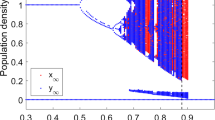Abstract
This paper considers the dynamics of a general nonlinear structured population model governed by ordinary differential equations. We are especially concerned with the survival possibility of structured populations. Our results show that, under a certain mild condition, the instability of the population free equilibrium point implies that the structured population survives in the sense of permanence. Furthermore, the relationship between the basic reproduction number and the instability of the population free equilibrium point provides simple criteria for population survival. The results are applied to both stage-structured and spatially structured models.
Similar content being viewed by others
References
A. Berman, M. Neumann and R.J. Stern, Nonnegative matrices in dynamic systems. Pure and Applied Mathematics (New York). A Wiley-Interscience Publication, John Wiley & Sons, Inc., New York, 1989.
A. Berman and R.J. Plemmons, Nonnegative matrices in the mathematical sciences (Revised reprint of the 1979 original). Classics in Applied Mathematics, 9, Society for Industrial and Applied Mathematics (SIAM), Philadelphia, PA, 1994.
H. Caswell, Matrix Population Models (second edition). Sinauer Associates, Sunderland, MA, 2001.
J.M. Cushing, An introduction to structured population dynamics. CBMS-NSF Regional Conference Series in Applied Mathematics,71, Society for Industrial and Applied Mathematics (SIAM), Philadelphia, PA, 1998.
J.M. Cushing and Z. Yicang, The net reproductive value and stability in matrix population models. Natur. Resource Modeling,8 (1994), 297–333.
O. Diekmann and J.A.P. Heesterbeek, Mathematical epidemiology of infectious diseases. Model building, analysis and interpretation. Wiley Series in Mathematical and Computational Biology, John Wiley & Sons, Ltd., Chichester, 2000.
O. Diekmann, J.A.P. Heesterbeek and J.A.J. Metz, On the definition and the computation of the basic reproduction ratioR o in models for infectious diseases in heterogeneous populations. J. Math. Biol.,28 (1990), 365–382.
F.R. Gantmacher, The theory of matrices, volume 1 (translated from the Russian by K.A. Hirsch, reprint of the 1959 translation). A.M.S. Chelsea Publishing, Providence, RI, 1998.
J. Hofbauer, A unified approach to persistence. Acta Appl. Math.,14 (1989), 11–22.
J. Hofbauer, An index theorem for dissipative semiflows. Rocky Mountain J. Math.,20 (1990), 1017–1031.
V. Hutson, A theorem on average Liapunov functions. Monatsh. Math.,98 (1984), 267–275.
R. Kon, Y. Saito and Y. Takeuchi, Permanence of single-species stage-structured models. J. Math. Biol.,48 (2004), 515–528.
Z. Lu and Y. Takeuchi, Global asymptotic behavior in single-species discrete diffusion systems. J. Math. Biol.,32 (1993), 67–77.
J.A.J. Metz and O. Diekmann, The dynamics of physiologically structured populations. Lecture Notes in Biomathematics,68, Springer-Verlag, Berlin, 1986.
M.A. Nowak and R.M. May, Virus dynamics: mathematical principles of immunology and virology. Oxford University Press, Oxford, 2000.
H.L. Smith and P. Waltman, The theory of the chemostat, Dynamics of microbial competition, Cambridge Studies in Mathematical Biology,13, Cambridge University Press, Cambridge, 1995.
H.R. Thieme, Mathematics in population biology. Princeton Series in Theoretical and Computational Biology, Princeton University Press, Princeton, NJ, 2003.
P. van den Driessche and J. Watmough, Reproduction numbers and sub-threshold endemic equilibria for compartmental models of disease transmission. Math. Biosci.,180 (2002), 29–48.
R.S. Varga, Matrix iterative analysis (second revised and expanded edition). Springer Series in Computational Mathematics,27, Springer-Verlag, Berlin, 2000
Author information
Authors and Affiliations
Corresponding author
About this article
Cite this article
Kon, R. Permanence of structured population models governed by ODEs and the basic reproduction number. Japan J. Indust. Appl. Math. 24, 17–37 (2007). https://doi.org/10.1007/BF03167505
Received:
Revised:
Issue Date:
DOI: https://doi.org/10.1007/BF03167505




